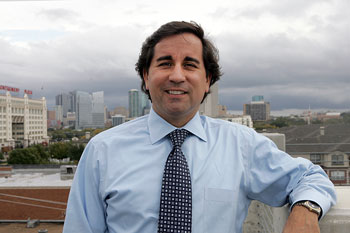On Aug. 29, Tarrant County College’s $192 million Center for Health Care Professions opened its doors to 700 students in downtown Fort Worth. Officially known as the Trinity River East Campus, it cost taxpayers a staggering $1,476 per square foot to build — more than three times what experienced real estate executives say such a facility should have cost.
 Almost before the first spade of dirt was turned on the project in 2004, it was the subject of major controversy; the uproar was a key factor in former Chancellor Leonardo de la Garza’s resignation in 2009. Half of the original project, planned for the north side of the river, was cancelled, and construction on the downtown side was put on hold for months. Eventually, however, the college district board decided they had no alternative but to finish it.
Almost before the first spade of dirt was turned on the project in 2004, it was the subject of major controversy; the uproar was a key factor in former Chancellor Leonardo de la Garza’s resignation in 2009. Half of the original project, planned for the north side of the river, was cancelled, and construction on the downtown side was put on hold for months. Eventually, however, the college district board decided they had no alternative but to finish it.
And the price could have been even worse — $11 million worse — had not several individuals and at least one company worked hard to bring down the costs, according to TCC board president Bill Greenhill.
Greenhill, who was elected last year, acknowledged the extraordinary price tag for the project, which he blamed on past mismanagement. He praised Chancellor Erma Johnson Hadley for bringing in a new team to get the project on track.
However, troubling questions remain about the hiring and performance of the members of that team. Some TCC critics — including some of the same citizen watchdogs who ferreted out problems with the downtown project in the past — are worried by what they see as more layers of expensive oversight being added without clear delineation of duties. One consultant, who has been paid more than $800,000, was hired without the college board signing off on his contract and despite the fact that his firm had been created only a month earlier with Tarrant County College District his only client.
Even with all those layers of oversight, an important permit process, apparently never followed despite repeated notifications to TCC by a state agency, could potentially wipe out much of that $11 million in savings, if full penalties were to be assessed.
Greenhill and others said that the search for someone to take control of the project began after a series of stories in Fort Worth Weekly pointed out myriad problems. Those ranged from disregard of historical preservation concerns to huge cost overruns, delays, lack of key permits, opposition from downtown leaders, and questions about the design of the northern section of the project that would have been built in part on the river levees. Consultants told the board that it would be difficult or impossible to recoup the district’s investment by selling the half-finished downtown portion of the project. Along the way, the district bought a second downtown campus, the former RadioShack headquarters a few blocks west, for another $238 million plus $80 million in renovations.
After the board voted to continue construction on the Trinity East Campus, Johnson Hadley, the new chancellor, hired Nina Petty in January 2010 at a salary of $195,000 to get the project back on track. Petty replaced Vice Chancellor David Wells in those duties. Wells returned to his post as vice chancellor of academic affairs.
Petty is a 25-year real estate professional who spent seven years as an officer with RadioShack. Her resumé shows she was in charge of all phases of development of the company’s corporate headquarters complex, built in 2002 on the site of the former Ripley Arnold public housing project.
Two months after Petty was hired by the college district, TCC also hired a former associate, Dennis Sewell, who had worked with Petty during the RadioShack construction. At TCC, like Petty, he was charged with getting the riverside campus finished, but on a consultant basis. In the last year and a half, Sewell’s company, of which he was the only employee when his contract was signed, has been paid more than $800,000 by the district.
Even though they clearly had misgivings about how the downtown campus was progressing, trustees never fired the company that has been overseeing that work for years. Project manager TPG+Parsons has been paid about $14 million by TCCD since August 2004. In October, the board extended its contract for a year.
In March 2010, the district’s law firm, Law Snakard & Gambill, acting on behalf of TCCD, offered a financial consulting contract to Sewell’s company, Sewell Advisory Services, to help “in developing a strategy for how TCCD will support or manage the project (Trinity River East) going forward.” The contract was for only one month and could be extended at any time by the college district.
Why the law firm was hiring a consultant for the district is unclear. No one from the firm returned the Weekly’s calls to answer that question.
Two months later, the district signed its own contract with Sewell, to run through September 2011. Even though that contract was worth several hundred thousand dollars, the board never voted on it. However, in another strange turn, the contract was recently extended by the board on a month-to-month basis, Greenhill said.
TCC public relations director Frank Griffis said the board was not required to approve the hiring of consultants.
Greenhill has praised the oversight team’s work. The board president gave particular credit to Sewell for bringing about the recent cost reductions.
“He really did some due diligence, spending hours examining documents, and ultimately found $11 million in savings,” said Greenhill. Sewell’s job, Greenhill said, was to “assist TCCD in overseeing the actions” of the construction site’s long-time project manager and “make sure every i was dotted and every t crossed.”
 One uncrossed t could come back to haunt the district, however.
One uncrossed t could come back to haunt the district, however.
In a March memo to Petty, Sewell concluded that the cost overruns and long delays were caused by a “culture of complacency … established years ago” coupled with an “attitude of just ‘rubber-stamping’ cost-related items.” He likened himself to a “guard in place” to hold TPG+Parsons as well as the builder, Austin-ConReal, and the sub-contractors accountable.
Still, a violation of a state law routed by Petty’s office to Sewell for resolution apparently fell between the cracks.
A document released to the Weekly in response to an open records request shows that Petty’s office received a notice last June from the Texas Department of Licensing and Regulation stating that under the Texas Architectural Barriers Act, the Trinity River East campus was required to have a plan review and site inspection to make certain it complied with Texas’ accessibility standards. The project had been registered with the state since 2006, the letter stated, but the required filing fee, review, and inspection fees were never submitted to the agency, as required by law. The district was given 30 days to provide proof that the requirements had been met.
Petty forwarded the information to Sewell who asked Parsons to “vet the issue,” according to the released documents.
But TDLR public information officer Susan Stanford said the district never did comply. “The district has not paid a filing fee or the review fee,” since the letter was sent out, she said, nor has there been a response. “The department will be contacting [the district], and the violation will be sent to our enforcement office,” she said. The fines can be hefty.
According to the letter sent to Petty, failure to pay the fees could wind up costing the district up to $5,000 a day in penalties for each violation going back four years — or $7.3 million.
Neither Petty nor Sewell has responded to numerous requests for comment on this story.
 When Sewell’s company received the TCC contract, he listed his experience as the development manager representing RadioShack on behalf of the Staubach Co., the project manager on the RadioShack headquarters job.
When Sewell’s company received the TCC contract, he listed his experience as the development manager representing RadioShack on behalf of the Staubach Co., the project manager on the RadioShack headquarters job.
He submitted one reference, printed out from a Staubach web site when he was with the company; it is not signed. It refers to his 20-plus years of construction experience, listing multimillion-dollar projects for JCPenney, Verizon, and IBM Solana. He holds a bachelor of science in construction sciences from Texas A&M University. The biography shows that he worked for Staubach for 11 years, rising to the post of vice president before leaving in 2008.
Prior to that, the biography states, he was with “a large commercial general contractor” that he did not name. There is no employment listed between the time he left Staubach in 2008 and was hired as a district consultant in 2010.
Although his resumé shows Sewell to have had decades of construction experience, his company was brand-new when it was hired by TCC. It had been registered with the secretary of state’s office on Feb. 4, a month after Petty was hired. Its only officer is Dennis Sewell, and its office is listed at Sewell’s home address in Trophy Club. In March 2010, the county college district became its first and only client. TCCD is its only client today, according to an addendum to his resumé.
No other consulting firms were invited to submit proposals. Sewell listed no prior clients or consulting jobs for reference.
Sewell’s initial contract paid him $275 an hour, to be billed to the law firm that would pass along the expense to TCC as a part of its monthly billing. According to the law firm letter-contract, Sewell’s services were to include advice “in connection with the design and construction of our client’s downtown campus … and … on all TCCD capital improvement projects.” He was to help determine a “project management transition strategy, evaluate current personnel, interview and make recommendations on prospective personnel, review current procedures for managing capital improvement projects, and make recommendations for restructuring [such projects].”
Other duties included the “observation of individuals employed by TCCD.” Sewell was to recommend whether TCC should continue with the construction-manager-at-risk concept on the river-bluff campus or convert to a lump sum contract.
Recommendations would include “steps to be taken to replace personnel associated to date with the project.” At least one person was replaced, the long-time manager of the project for Parsons.
The later contract with the district, signed by Johnson Hadley, was for the same duties, but Sewell’s fee was reduced to $250 per hour. However, an additional fee of $30,000 per month was added “to cover a full-time, on-site owner’s representative.”
The fee was added to Sewell’s hourly fee and paid directly to him. He then hired an associate to assist him with the on-site observations of the construction crews and project manager.Drew Schott, the assistant, was paid around $100 an hour out of the $30,000. The balance was retained by Sewell’s company, according to the terms of his contract.
The recently extended contract appears to drop that fee, reducing Sewell to $206 an hour and adding a $150 per hour fee for a senior project manager. The terms of the contract cap Sewell’s fees at around $600,000 for nine months.
 From August 2004 through August 2011, the district also paid Parsons, its long-time project manager, $14 million to perform basically the same duties as Sewell. Parsons had come under fire in the e-mails from Sewell for its complacency in overseeing contractors and sub-contractors and from the architect Bing Thom of Vancouver, B.C., for its “erratic behavior” toward the design team (without clarification). Despite that, the board recently renewed Parsons’ contract as well.
From August 2004 through August 2011, the district also paid Parsons, its long-time project manager, $14 million to perform basically the same duties as Sewell. Parsons had come under fire in the e-mails from Sewell for its complacency in overseeing contractors and sub-contractors and from the architect Bing Thom of Vancouver, B.C., for its “erratic behavior” toward the design team (without clarification). Despite that, the board recently renewed Parsons’ contract as well.
Calls to Parsons for comment were not returned.
Greenhill said that when he and trustee O.K. Carter heard of the Sewell deal, they both asked the chancellor why they couldn’t simply hire Sewell at a reasonable salary as Petty’s assistant. “That would have been a lot cheaper,” he said.
Ironically, Greenhill was told that there was no money in the budget for that cheaper route. But there was money in a special fund set aside to pay professional consultants — which could explain why Sewell was hired as a consultant rather than an employee, but not why he had to be paid at such rates.
Under the state’s education code, professional consultant contracts do not have to be put out for bids. However, consultants are supposed to show expertise in their fields, primarily via some kind of state or federal licensing. And the code tells government entities they “shall make the selection on the basis of demonstrated competence and qualifications to perform the services; and for a fair and reasonable price.”
Bob Mhoon, an Arlington military retiree and former adjunct professor at TCC, keeps a close eye on public spending, particularly at TCC. In his eyes, the Sewell contract raises more questions than it answers.
“What’s most perplexing is that TCC didn’t look for an equally qualified consultant at a much lower cost,” Mhoon said. He also questions why Sewell’s initial contract never went to the board to be voted on in a public meeting.
 “Why was the contracting process structured in a manner designed to deliberately bypass public scrutiny? Even if that process was totally in accord with established policy, it was the wrong thing to do,” he said, especially by an administration that came in promising “complete transparency.”
“Why was the contracting process structured in a manner designed to deliberately bypass public scrutiny? Even if that process was totally in accord with established policy, it was the wrong thing to do,” he said, especially by an administration that came in promising “complete transparency.”
(Several e-mails refer to efforts to placate the media or to couch decisions in words that the press wouldn’t criticize. Marvin Daniels, vice president of Parsons, sent Petty a “fact sheet” that he said could be used to “accomplish our mission of informing the public with the right level of information.”)
Petty’s job description, Mhoon said, shows that she should have been doing all the things asked of Sewell. “She is being paid to do exactly what Sewell is being paid to do,” he said.
In addition, according to documents released by the district, Petty has an assistant whose job description mimics that of Sewell’s.
The e-mails released by the district show discussions among the various team members — including the architect, project manager, and Petty — about the feasibility of firing the general contractor, Austin-ConReal, and rebidding the entire project due to its excessive cost and long delays.
Both ideas were discarded by Petty after consulting with Parsons’ manager Daniels, who pointed out the difficulties of rebidding in a two-page memo. The project by then was 85 percent complete, he wrote, and such a rebid could drive costs even higher, cause more delays, and hurt minority firms that were involved. The documents do not show that Sewell was consulted or gave any recommendations about rebidding the contract.
In the March 2011 memo to Petty that described his accomplishments in order to justify his contract, Sewell listed his work in renegotiating fees with the contractor, the project manager, and the architect that saved the district about half of the $11 million.
But the e-mails show that most of the hard-nosed negotiating was done by Petty.
Sewell found smaller savings in things such as cheaper fill dirt for the college’s planters, replacing concrete benches with movable manufactured ones, relocating bike ramps, and calling for a redesign of a roof to meet the manufacturer’s warranty.
In one case, Sewell found that Thom was double-billing and a contractor on another project was overbilling “in excess of $25,000.” Both acts were stopped. There is nothing to indicate any action was taken against the companies.
All of the above, Mhoon believes, could have been done by either Petty or her assistant.
Johnson Hadley did not respond to requests for an interview. In a memo provided to the Weekly on behalf of the chancellor, public relations director Griffis wrote that the chancellor credits Sewell for his “money-saving work” that “in a short period of time [resulted] in taxpayer savings and classes being opened on time.”
The stark concrete and glass buildings, compared to a “minimum-security prison” by Carter as they were being built, rise from a deep cut in the Trinity River bluff on the south side of the river, a fact that caused great anguish within the county’s historical societies. The campus is just a short walk from the century-old Tarrant County Courthouse.
Now that they are complete, the buildings are drawing praise. The oddly angled gray structures are flooded with natural light by the addition of huge glass windows that bring warmth to the buildings’ earlier coldness. They house 20 classrooms, a simulated hospital with computerized mannequin patients on which health profession students can hone their skills, a café, and numerous foliage-filled common areas. Other amenities include an outdoor classroom, a three-acre sunken plaza and coffee bar open to downtown pedestrians, a waterfall, and a tree-lined walkway to the river. The sunken plaza with its walkway to the river, which had drawn criticism from downtown players such as Ed Bass, is open and airy, not the dark, foreboding “tunnel” that its critics envisioned.
Folks like former city council member Clyde Picht still aren’t impressed by what the taxpayers got for the project’s bloated price tag. “This is the fault of an incompetent chancellor and trustees that don’t give a hoot about low-cost education,” Picht said. “I don’t know how they justify such a cost,” he said.
Kyle Poulson, a major player in the development of the West 7th Street corridor and a principal with one of the nation’s largest real estate developers, Transwestern called the Trinity East cost “unbelievable” and a “horrible use of taxpayer dollars.”
”The campus is very impressive,” Poulson said. “But I guess that’s easy to do when you have unlimited funds, no budget, and no one asking questions.”
“There is no justification” for the price tag, Greenhill agreed. A partner with the Haynes and Boone law firm, Greenhill was elected as a reform candidate along with retired journalist Carter of Arlington. The downtown campus’ disproportionate costs were the reason both decided to run. But now that the deal is done, the campus is lovely, and it’s “time to move on,” Greenhill said.
Although de la Garza, the former chancellor, had touted the massive construction fund he built up as a way to do such projects without raising taxes (and also without having to ask for voter approval in a bond election), that has turned out not to be true. Picht pointed out that, due to the excessive cost of the riverside campus, the board voted in August to raise tuition and property tax rates in order to fund other capital projects. Starting next spring, basic tuition will rise from $50 per semester hour to $52. Property tax rates will go up by one cent to 14.897 cents per $100 of assessed value, raising the average tax bill by $15 a year.
Picht is convinced that the campus was built downtown rather than in the hospital district, where a health professions building would have made more sense, because educational considerations were never the driving force behind the project. The real impetus, he believes, was to add to the viability of the Trinity River Vision project, the massive and also highly controversial effort to reshape the area just north of downtown. Bing Thom, the architect on Trinity River East, is also deeply involved in the TRV project.
J. D. Granger is executive director of the TRV Authority and son of U.S. Rep. Kay Granger, who has been instrumental in getting federal funding for the river project. He said the downtown campus was always part of the TRV plan, primarily due to the ideas of Thom, who believes students should be part of an urban setting.
Plus, Granger said, the timing was right — just as the TRV was getting off the ground, the college was looking for a downtown site. With Thom as architect for both, “they came together perfectly,” he said.











